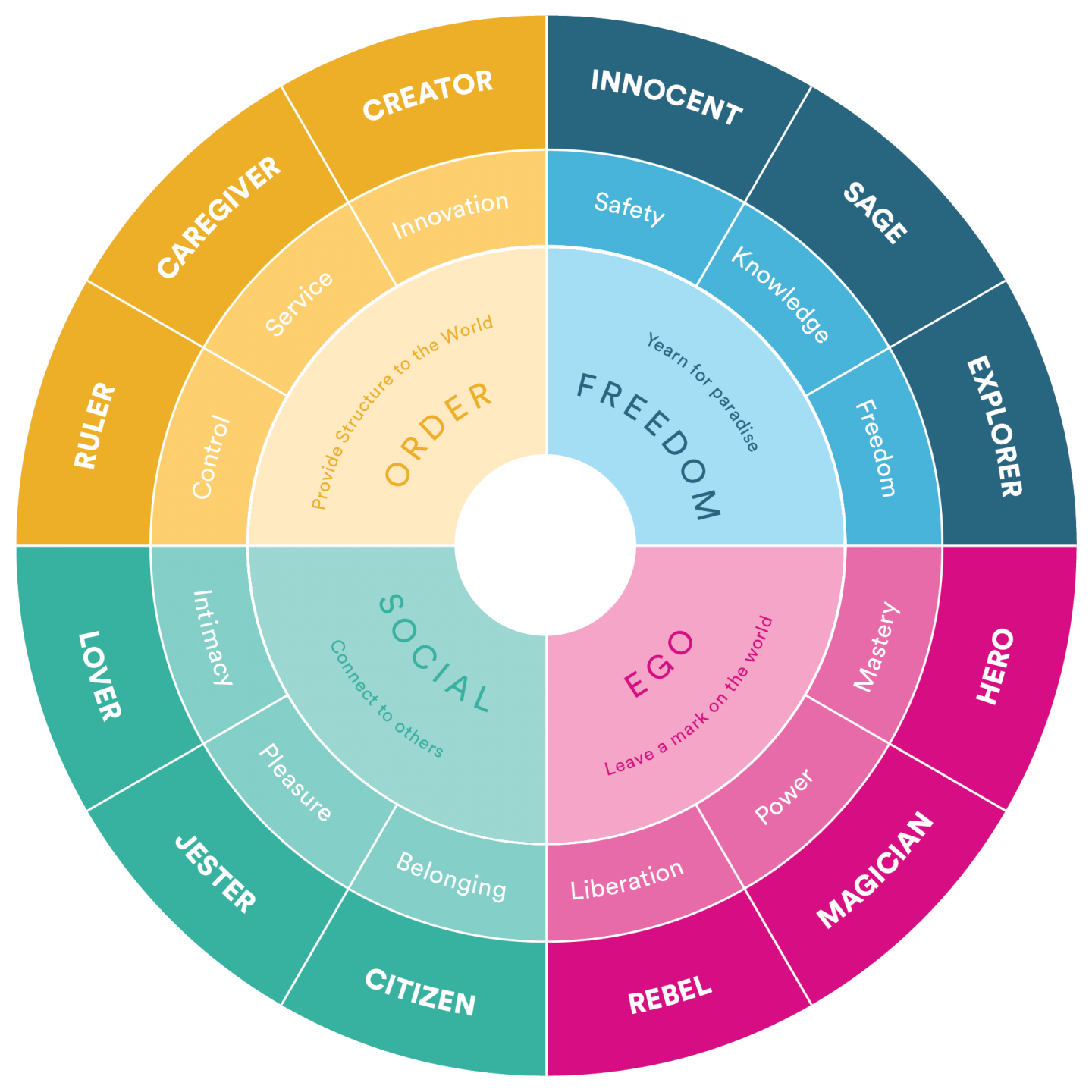
The biggest companies in the world make their brands more attractive and understandable by using brand archetypes to inform their brand identity.
Have you ever been instinctively drawn to a brand, without really knowing why? Turns out there’s science behind it. You might remember a campaign after 10 or 20 years: not because you rushed out to “buy”, but because the whole experience made you laugh, relate, cry, think. We remember a brand because of how it makes us feel.
What are brand archetypes?
Archetypes help us to understand the intrinsic meaning of product categories and consequently help marketers create enduring brand identity that can establish market dominance, evoke and deliver meaning to customers, and inspire customer loyalty. – Carol Pearson & Margaret Mark, The Hero and the Outlaw
The concept of the archetype has its roots in psychology and storytelling.
Appealing to the subconscious, archetypes bypass the intellectual mind and produce a feeling that lingers, organically leading the consumer to feel a sense of loyalty.
In doing this, they’re a kind of bridge that can connect the conscious and subconscious.
Here are the famous people who developed this concept originally:
-
- Sigmond Freud’s theory of psychoanalysis introduced the concept of the subconscious mind. His work suggests that behaviors are influenced by our innermost thoughts.
- Carl Jung advanced Freud’s concept into the collective subconscious, where shared experiences reside. His work suggests the idea of universal archetypes.
- Joseph Campbell integrated human experience through mythology. His work points to a universal journey we use as a metaphor for storytelling.
Brands based in archetypes are “felt” because they somehow manage to get into our minds and hearts and stay there.
Why are brand archetypes such powerful tools?
Like psychologists and storytellers, in branding we study human nature, asking core questions like:
-
- What messages will reach them?
- How do people think?
- What resonates?
- What moves them to take action?
Although great branding is expressed through things like ad copy, logos, and jingles— the magic really lies in a carefully crafted strategy that paves the path to simple, bold, and consistent messaging. Brand archetypes provide a reliable framework for instilling meaningful concepts that are universally understood.
1. Archetypes Prevent Brand Inconsistencies
When it comes to branding, attitude and personality are more powerful than product information. Building a strong brand relies on strong opinions that resonate with your targeted audiences. Your brand identity must be confident and non-apologetic, because brands take stands.
Aligning with a brand archetype helps ensure that you have a:
-
- Consistent tone in your marketing activities
- Personality which appeals to your target market
- Clear purpose
- Consistent framework for communications and campaigns
- Unified set of objectives for creatives and marketers
Brand archetypes also prevent constant reinvention which can distract your audience and throw them off-course, where they’re likely to drift over to a competitor.
2. Archetypes Enhance Brand Trust
Strong brand recognition isn’t just about logos. The most powerful brands are known without words: Almost everyone would recognize brands like Nike and Mac because they maintain their personality. It is this level of recognition that forms the basis for a brand story and values the whole journey people will take from initial awareness to loyal customers.
Brands that align clearly with an archetype reflect the aspirations and sentiments of certain types of people. This supports market segmentation and targeting a specific niche. Familiarity with iconic legends evokes memorable, emotional reactions. This bypasses the intellect and appeals to the subconscious.
Traditionally, marketing sought to understand audiences by demographics. But with increasingly complex communications systems and extensive profiling data, it’s evolved into psychographics and ethnographics— the realm of cognitive orientation.
Brand archetypes help us engineer a predictable reaction with our target audiences.
12 Universal Archetypes

Learning about the 12 universal brand archetypes will give you a framework for establishing a brand’s position.
Freedom Motivated Archetypes Yearn for Paradise
1. The Innocent archetype is rooted in safety, security, optimism, goodness, youth. Their motto is “Free to be you and me.”
Examples: Dove
2. The Sage believes in knowledge, insight, thoughts, and the mind. Their motto is “The truth will set you free.”
Example: Google
3. The Explorer yearns for travel risk discovery freedom. Their motto: “Don’t fence me in.”
Example: Jeep
Ego-Motivated Archetypes Want to Leave Their Mark on the World
4. The Rebel craves freedom and liberation. Their motto: “Rules are made to be broken.”
Example: Harley Davidson
5. The Magician believes in the power to create almost anything, with the motto “I make things happen.”
Example: Disney
6. A Hero will triumph, no matter what kind of adversity they face. Their motto: “Where there’s a will, there’s a way.”
Example: Nike
Socially Motivated Archetypes Yearn to Connect With Others
7. The Lover craves romance, sex, intimacy, and only has eyes for that. Their motto is “You’re the only one.”
Example: Chanel
8. The Jester wants fun, pleasure, and lives for the day. They’re funny, too, with the motto: “You only live once.”
Example: Ben & Jerry’s
9. The Citizen is down to earth, appreciates the simple thing, craves belonging. They believe in humility and equality.
Example: Home Depot
Order Motivated Archetypes Provide Structure to the World
10. The Ruler believes in the best-of-the-best. They want control, and seek to make order out of chaos, and believes “Power isn’t everything, it’s the only thing.”
Example: Mercedes-Benz
11. The Caregiver leads a life of service, with the motto “love thy neighbor.”
Example: UNICEF
12. The Creator is a dreamer, builder, innovator, artist. They believe that “if you can imagine it, it can be done.”
Example: LEGO
Which archetype reflects your brand?
Even if you’ve never thought about it before, there is certainly a brand archetype for your business, or you might have a combination of the two. If you think about the brand archetypes, and likely you’ll find the ones that reflect your company’s spirit.
For us, we identify with the Explorer and Creator archetypes at Flux Branding. We lead clients through times of change by helping reveal their true brilliance. It’s a passionate dream that we’re constantly innovating and building. Our brand archetype reminds us of who we are, and helps keep us consistent in a rapidly evolving marketplace.
But how does this translate to actual business? Well, it’s only the first step.
The most important rule is that your brand archetype must be authentic to your core business principles: your mission, values, purpose. Those should never change, and neight should the archetypical foundation of your brand.
It isn’t always easy, but when it’s done properly it’s the basis for establishing deep and long-lasting customer loyalty.
Great Branding Takes Thought and Strategy
Learning about brand archetypes can help you gain traction against your competitors.
Take the time to understand how your agency works before jumping in with both feet.
Once you leap, trust the experts you’ve selected.
We’ll help you learn about your own brand archetype. Contact us to discover the possibilities.
Suggested Reading
Sigmund Freud, The Interpretation of Dreams
Carl Jung, Psychology and Religion
Joseph Campbell, Hero with a Thousand Faces
Joseph Campbell, The Power of Myth
Caroline Myss, Sacred Contracts
Carol Pearson & Margaret Mark, The Hero and the Outlaw
Clotaire Rapille, The Culture Code
Tom Kelly, The Ten Faces of Innovation
Edith Hamilton, Mythology
Clarissa Pinkola Este, Women Who Run with the Wolves
Bruce Tallman, Archetypes for Spiritual Direction
Margaret Pott Hartwell & Joshua Chen, Archetypes in Branding
Daniel Pink, A Whole New Mind
Enjoyed this article? Here are three more to help you:
Home is a Feeling (So is Your Real Estate Brand)
Habits & Rituals: The Holy Grail of Branding (Part 2)
Clarity Between Cycles
This article was originally published in 2019 but has been updated in 2020.